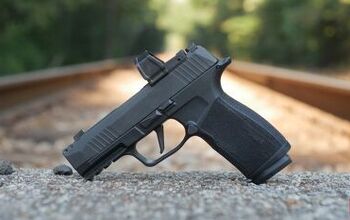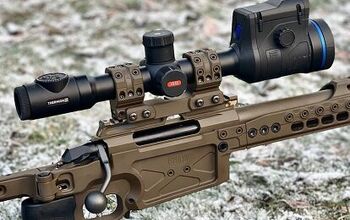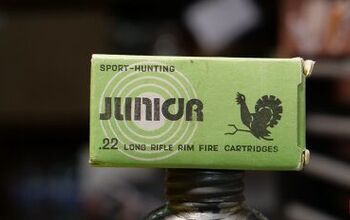TFB Review: Pulsar Thermion 2 LRF XP50 Pro Thermal Riflescope

This is a review of the Pulsar Thermion 2 LRF XP50 Pro, which Pulsar claims is the first thermal imaging riflescope with a classic design and built-in laser rangefinder. Loaded with features and some of the most powerful components available on the market, like the EU-made 640×480 sensor, this is definitely one to evaluate if you’re looking for a premium thermal rifle scope.
Pulsar @ TFB:
- TFB Review: Pulsar Talion XQ38 – Budget Thermal Riflescope
- When Spectrums Collide – Pulsar Thermion 2 XP50 LRF Pro on H&K MR223
- Pulsar PSP-V Adapter – Attach your Thermal to Picatinny
- TFB Review: Pulsar Digex C50 – Digital Day & Night Vision Riflescope
- [IWA 2022] High End, Reasonably Priced Thermal Scopes from Pulsar
As soon as the Thermion 2 LRF XP50 Pro was released at the beginning of 2022, I bought one of the first on the market. I was a happy owner until I got an offer I couldn’t refuse, from a fellow hunter. Pulsar where then kind to send me a loaner, so this review is based on two samples over about 7 months. I had no issues with either. Over time I have tested the Thermion 2 LRF on a wide variety of firearms. From a Heckler & Koch MR223 for the fun of it to a Browning BAR Match (perfect for wild boar) to more traditional hunting rifles.
The same goes for all of the situations where I’ve tried the riflescope. From just playing around the house, putting it on a tripod in front of a feeder and watching wild boar to stalking and other real hunting situations.
Below: The Pulsar Thermion 2 LRF XP50 Pro mounted on a Browning BAR Match .308 Win. The housing is waterproof IPX7. The front cap is hinged. Rekon Tripod and saddle.
Perfect Precision! With a red Accuracy International AT-X around, yeah I had to try that as well, and it looked excellent. What could have been better? A blue AT-X, of course! To go with the blue ring on the Pulsar.
First Impressions and Ergonomics
The quality from Pulsar is instantly visible. Overall you get a good feel, and my thoughts go to the high-end German and Austrian manufacturers of optics. If there were any shortcuts taken in terms of material or surface finish, I sure can’t detect them. It’s clear that a professional industrial designer (or most likely a team) had their say when the Thermion 2 LRF XP50 Pro was designed.
Below: The Thermion 2 models have an internal battery as well as an interchangeable, rechargeable one. Changing the external batteries is very easy, even in darkness. You can use an external power supply via USB as well.
I’m quite used to the look of the Thermion series by now, and the LRF unit does look a bit odd with the rangefinder looking like a brick mounted on top of the objective. I’m getting used by now, and I don’t really see how Pulsar could have put it in any other place either.
The ergonomics work so well, that it almost gets boring to talk about it. The only real issue I have is that the scroll wheel (on the left side/turret) sometimes goes one click further than I wanted, as I click the confirm button. It’s a bit irritating. Having just reviewed the Pulsar Talion XQ38, I would prefer that kind of control on the Thermions as well.
The new ambidextrous focus wheels (one on each side) is a huge step forward. They work great and smooth and are such an improvement versus the previous design.
Below: I repeat my message that I see a lot of thermals with cheap mounts, like you don’t have to care about zeroing when you’re hunting at night? Please think again and get yourself a quality mount that stays where you want it. Here you see the Spuhr SP-3002 cantilever (mounted) and a Quick-Detach version.
In terms of firmware and software, I do prefer the menu system on the Pulsar Proton and Krypton units, which use a round menu to choose from instead of a list.
Technical Specifications
The thermal sensor is made by Lyndred in France and has 640×480 @ 17 µm, 50 Hz frame rate. The NETD is
The objective lens is F50 / 1.0 with a magnification between 2 – 16. The detection range is said to be 1800 meters. The eye relief is set at 50 mm. The screen you will be looking at is 1024х768 pixels AMOLED.
Personally, I enjoy a low base magnification. Fox hunters may enjoy the Thermion 2 XQ50 (or upcoming versions) more, with a 3-12 magnification range.
Image Quality
We lose one of our most important senses when it gets dark, but night vision and thermals help us. The better the image, the better we can make judgments and avoid hunting mistakes. Darkness also makes it really difficult to try to estimate distances, and a flat 2D image rarely helps. Here the LRF, Laser Range Finder, comes in really handy. By the press of the button, you can accurately measure the distance to your target, one at a time or put it on scanning and get constant readings.
Below: Wild boar filmed in the snow-covered ground at -16C (3F). The Thermion didn’t complain as much as I did. These beasts came as close as 12-15 meters, which is scary. The Thermion is not attached to a firearm, it’s on a tripod.
With the device completely shut off, it takes only a few seconds before you have a thermal image, and Pulsar’s devices usually stand out with this feature. Some devices I’ve tried take up to 20 seconds before they give you something to watch, so if this is important to you, make sure you try this out before you buy.
Below: I think modern thermals, at least the high-end ones, are able to produce a nice depth in the image. It’s more clear “live” than in these still images. Note the antlers or the roebuck. You wouldn’t see these in a poor man’s thermal. The LRF is set to “true distance” so it calculates the drop or increase in elevation.
Thermal sensors and Germanium lenses are expensive and the Thermion 2 has some of the best components available on the market. This shows when you’re looking through the ocular. I have tried a few top-of-the-line thermals and the Thermion 2 will give you an outstanding image quality.
Below: Note the soccer goal.
The forest comes alive at night.
A rabbit at 33 meters.
Some more wild boar. Notice the details. In many countries in Europe, it would be forbidden to hunt this one (wild bore sow, apparently with piglets nearby.)
Below: And suddenly the piglets appear.
Below: Yeah, we know you’re out there. We just accept it, kind of, since we’re frozen and hungry. The base of the feeder can be seen to the left.
Below: I don’t think people realize just how sensitive thermals are. There’s no hiding! This is a mouse running over a road.
Below: A bit further away. Wild boar family crossing a road. The red square is the LRF, so the real distance is a little longer. I was trying the get the best image of the hogs.
Below: Wild boar everywhere!
Below: Feeding time again! This time in the springtime.
Below: Suddenly a fox appears at about 30-40 meters. Then it catches my smell and runs away. When you see this live, the image quality appears much better.
Below: This field is normally more crowded than this.
Below: The same field, a wild boar family appears and the others move away.
A herd of Mouflon sheep at 55 meters, moving away from me. These creatures are incredibly difficult to spot. Look how detailed the image is (and there’s been a loss of quality as I resized the images), and how you can make out details in the nature (there’s high grass very close). In the ocular, it appears like a black and white video with the black/white hot setting. Filmed early spring, extremely windy and with some rain.
Mouflon sheep look like creatures of Darkness when on black hot. Notice the depth in the image.
Here are some videos:
Roebuck with antlers
Quality & Production
Earlier this year, I had the opportunity to visit the Pulsar factory and HQ in Lithuania. There’s no room in this review to go into detail about the visit, but it gave me a better understanding of how the units are manufactured and all of the optical and mechanical quality checks involved. I had these images cleared by Pulsar, where you can see thermal riflescopes being assembled and shock tested.
Below: Shock testing of each and every Pulsar Thermion before shipping.
Suppressed Heckler & Koch MR223.
The price level seems to be in the region of $6,000 in the USA, and similar in Europe. The Pulsar Thermion 2 models are made in Lithuania (Europe). The thermal sensor is made in France.
Pulsar Thermion 2 LRF XP50 Pro with the Axion 2 XQ38 LRF thermal spotter.
Below: Browning BAR Match with some Concamo camouflage, which totally makes the rifle disappear in this environment. Magpul bipod sticking out.
Below: Browning BAR Match with Thermion 2 LRF XP50 Pro. Everything is resting on a carbon fiber tripod from Rekon Outdoor Gear and a PIG saddle from Shadow Tech. Camoflauge from Concamo. A huge thanks to Scott Country International for helping me out with the tripod and the saddle.
Below: The Pulsar “Battleship”. Mounted on a MOD DOS multi-functional platform you see Talion (left), Pulsar Axion 2 LRF thermal spotter and Thermion 2 LRF XP50 Pro. This setup makes it easy to evaluate the performance of optics side-by-side at the same time and tell you which one is the best and why. The one to the right is a clear winner.
EDIT – Just as this review was finished, Pulsar Vision launched a Firmware 2.0 upgrade. I quickly upgraded so here’s a sample image from the new Pulsar Merger LRF XP50 binoculars to give you an idea. There’s a video here, with breathtaking clarity for a commercial thermal. Distance to the houses, is about 160 meters.
Below: The Thermion 2 LRF XP50 Pro with firmware 2.0 here, taken an hour later. All other images in this review were taken with the previous firmware. No firearm attached.
Conclusion
The Pulsar Thermion 2 LRF XP50 Pro is Pulsar’s top-of-the-line thermal rifles scope and it shows. On top of that, they added an integrated laser rangefinder, a feature hunters have been begging for for a long while. The image quality is clear and superb and the performance cuts through fog and mist, almost like it didn’t exist.
The LRF is very fast and you can turn it on to scan all of the time. Occasionally you get a reading wrong, but it happens with all LRFs in my experience, regardless of price. I have scanned out to the maximum 800 meters with no issues.
With new internals and firmware, the battery life has improved quite a lot with previous Thermion models.
So what’s not to like? For starters, the price tag is going to scare away quite a few, but looking at reviews and videos like this one is for free. Just remind yourself to fill that hidden Spec Ops wallet up over time, so it can be purged for occasions like this. At just below one kilogram, it’s certainly not light, but I can’t really see any competitors offering a lightweight option either. Quality thermals make your wallet thin and your rifle heavy!
Check Prices on Pulsar Thermion 2 LRF XP50 Pro Thermal Scopes
If you want a slimmer option, with a similar thermal performance, you can check the upcoming Talion XG35 which has a 640×480 @ 12 µm (NETD

Ex-Arctic Ranger. Competitive practical shooter and hunter with a European focus. Always ready to increase my collection of modern semi-automatics, optics, thermals and suppressors. TCCC Certified. Occasionaly seen in a 6x6 Bug Out Vehicle, always with a big smile.
More by Eric B




































































![[SHOT 2025] Mars Inc.’s Precision Grenadier System](https://cdn-fastly.thefirearmblog.com/media/2025/01/24/07511/shot-2025-mars-inc-s-precision-grenadier-system.jpg?size=350x220)



Comments
Join the conversation
I’m just here for the fire truck rifle comments.
A pistol for the poors (pulls out Laugo Alien)